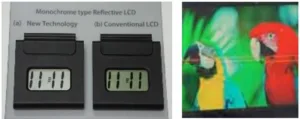Reflective displays have the potential to dramatically reduce power consumption. Unfortunately, a common trade-off in the operating principle of such displays is that light reflected from the display is dispersed in a Lambertian-like pattern. This statement is primarily made with reflective electrophoretic display technology in mind. The result of this tradeoff is a display that produces an image with limited contrast and brightness. A team of researchers in the Graduate School of Engineering, Department of Electronic Engineering, Tohoku University (Sendai, Japan) are developing a technology to address this deficiency.
The most recent results of the team, led by associate professor Takahiro Ishinabe, is entitled “A low-power reflective display with a wide color gamut.” This article is available on the SPIE website and can be found here.
The approach under development by the team is based on a reflective color liquid crystal display. Implementing this approach makes it necessary that the optical components in the display be achromatic and that improved control of the angular diffusion of the reflected light is achieved. To meet these goals, a mirror electrode is incorporated into the display as is a film designed to diffuse light only in the direction in which the light is traveling.
The first challenge in making the reflectivity achromatic is related to the conventional iodine-based polarizers that sandwich the display. Such polarizers, typically made from stretched PVA, generally absorb between 480 and 600 nm but the absorption is not uniform. As a result, when two polarizer are parallel, the visible light transmittance has a slight yellow tint.
It is found that the absorption characteristics of the polarizer is highly dependent on the conjugate structure of the molecules. With this in mind, the team replaced the iodine with a newly synthesized dichroic pigment. In addition, a new technique was developed for impregnating the dichroic pigment and a crosslinker into the PVA film before the stretching process. This enabled the alignment direction of each pigment to be controlled and resulted in an improvement in the dichroic ratio of the polarizers. Details on the process are presented in the article.
The results show the transmittance of the polarizer to be uniform in the visible wavelength range, representing a considerable decrease in chromaticity as compared to traditional iodine-based polarizers.
The light diffusion film was fabricated by exploiting a polymerization-induced phase separation effect. By altering the diffusion angle of the UV light used for polymerization, it was found possible to control the internal refractive-index distribution. To achieve a widely diffused light distribution similar to white paper, the team fabricated two diffusion layers on a single polymer film using a two-step UV irradiation process. Stated more broadly, the technique provides a method to control optical diffusion by selecting an optimum layer structure and tuning the diffusion angle of UV light. Again, details can be found in the article.
Using the new achromatic polarizer and light diffusion layer, the team fabricated prototype monochrome and full color reflective LCDs.
The figure below and on the left shows a monochrome reflective LCD based on the new technology. This is in comparison to the central figure which shows a conventional reflective LCD. Note that, for comparison, the text in these two images is displayed on a Kindle electrophoretic display. The figure to the right is a reflective color LCD fabricated using the new techniques.
In the new display, both the reflectivity at L*=71 and the extent of the achromaticity were determined superior to that found in conventional monochrome electrophoretic displays. In addition, the team reports that the color gamut is wide at 50% of the NTSC color standard and that the display has a “wide viewing angle and motion image capability in a full-color reflective LCD.”
The team is currently working to improve the dichroic ratio of the achromatic polarizers so as to further improve the reflectivity of the liquid crystal display. -Arthur Berman
Tohoku University, Takahiro Ishinabe,+81-22-795-7119, [email protected]

